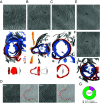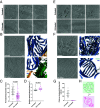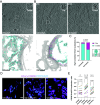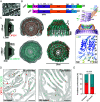In situ cryo-ET visualization of mitochondrial depolarization and mitophagic engulfment
- PMID: 40743392
- PMCID: PMC12337332
- DOI: 10.1073/pnas.2511890122
In situ cryo-ET visualization of mitochondrial depolarization and mitophagic engulfment
Abstract
Defective mitochondrial quality control in response to loss of mitochondrial membrane polarization is implicated in Parkinson's disease by mutations in PINK1 and PRKN. Parkin-expressing U2 osteosarcoma (U2OS) cells were treated with the depolarizing agents oligomycin and antimycin A (OA) and subjected to cryo-focused ion beam milling and in situ cryo-electron tomography. Mitochondria were fragmented and devoid of matrix calcium phosphate crystals. Phagophores were visualized, with bridge-like lipid transporter densities connected to mitophagic phagophores. A subpopulation of ATP synthases relocalized from cristae to the inner boundary membrane. The structure of the dome-shaped prohibitin complex, a dodecamer of PHB1-PHB2 dimers, was determined in situ by subtomogram averaging in untreated and treated cells and found to exist in open and closed conformations, with the closed conformation being enriched by OA treatment. These findings provide a set of native snapshots of the manifold nano-structural consequences of mitochondrial depolarization and provide a baseline for future in situ dissection of Parkin-dependent mitophagy.
Keywords: autophagy; cryo-ET; mitochondria; mitophagy; prohibitin.
Conflict of interest statement
Competing interests statement:J.H.H. is a cofounder of Casma Therapeutics and member of the scientific advisory board.
Figures





Update of
-
In situ cryo-ET visualization of mitochondrial depolarization and mitophagic engulfment.bioRxiv [Preprint]. 2025 Mar 25:2025.03.24.645001. doi: 10.1101/2025.03.24.645001. bioRxiv. 2025. Update in: Proc Natl Acad Sci U S A. 2025 Aug 5;122(31):e2511890122. doi: 10.1073/pnas.2511890122. PMID: 40196634 Free PMC article. Updated. Preprint.
References
MeSH terms
Substances
Grants and funding
LinkOut - more resources
Full Text Sources
Research Materials

